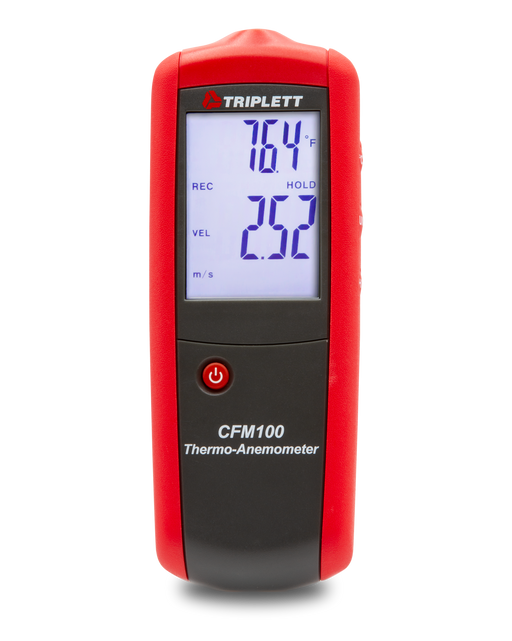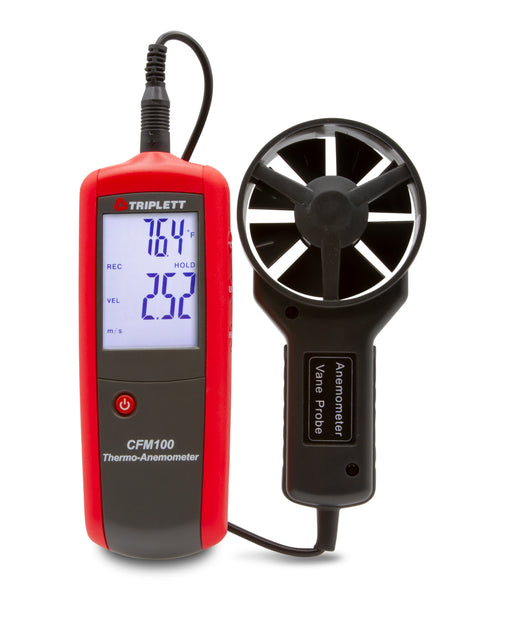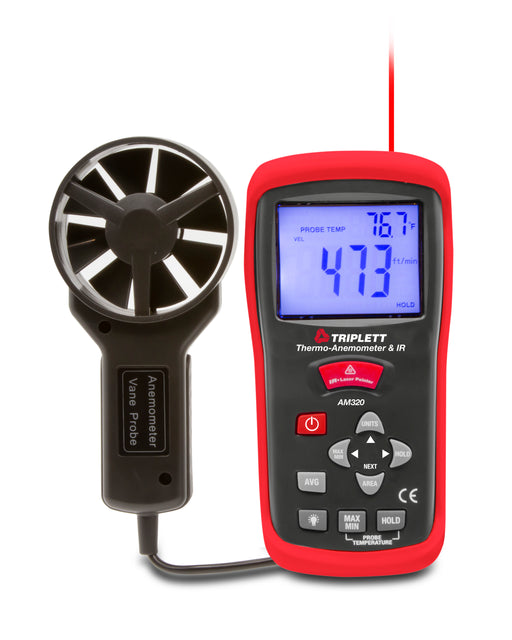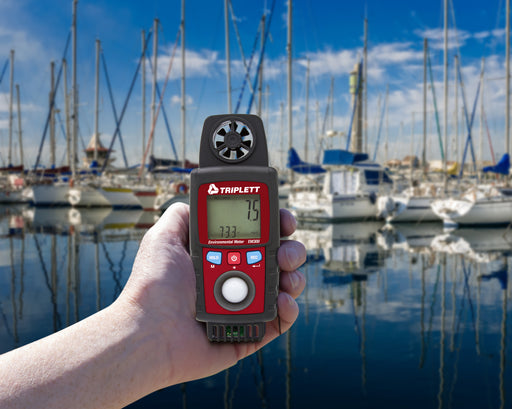Know More About Triplett Vane Anemometers
Importance of Airflow Measurement
The significance of airflow measurement in outdoor applications is largely evident. However, it finds applications in indoor segments as measuring the airflow within a system or machine gives an idea about energy consumption, fan motor efficiency, heat losses, and so on. Wind vane anemometers find uses in HVAC systems, boiler systems, open-cell foams and other air tool applications. Vane anemometers are used to measure airflow among other parameters. They have vanes or blades directly facing the airflow. These vanes rotate at a speed based on that of the wind, which means the two are directly proportional to each other. They help measure the amount or volume of air passing from a pipe or duct of a system in a specified timeframe. This can be calculated by measuring air velocity with help of a portable wind meter and multiplying it by the pipe or duct area. All these measures help achieve a comfortable indoor environment, increase the energy efficiency of the machine or system, and ensure good air quality and ventilation.
Working Principle of Vane Anemometers
Vane anemometers are devices used to measure the velocity of air or gas flow. The device consists of a rotating vane (or propeller) mounted on a spindle, which is placed in the airflow. As air passes through, it spins the vane, with the rotational speed being directly proportional to the flow velocity. This straightforward design makes vane anemometers easy to use and reliable in a variety of settings, facilitating accurate and reliable airflow measurements. These measurements are essential for maintaining ventilation systems, ensuring workplace safety, and conducting environmental assessments.
- Rotational Speed Measurement: Vane anemometers function by using a rotating vane, or propeller that is set into motion when exposed to moving air. The speed of rotation is directly proportional to the velocity of the airflow. As air passes through the vane, it spins at a rate that is then measured by a sensor or readout device.
- Conversion to Air Velocity: The rotational speed of the vane is converted into air velocity readings using calibration data specific to the anemometer. This allows for a precise measurement of airflow, which is critical in applications that require accurate monitoring of air movement.
- Temperature Compensation:Many vane anemometers also include temperature sensors, which allows them to adjust readings based on air density changes due to temperature variations, enhancing the accuracy of their measurements.
Benefits of Using Vane Anemometers
Many industrial applications require vane anemometers for wind speed measurement, whether indoor or outdoor. This is because the rotating vane anemometers work in sync with the wind speed. Our devices are absolutely handy, reliable, and easy to use. Also, they have multiple functionalities. Here are some benefits of using our anemometers.
- Our models are designed to measure accurate air speed as well as may other parameters such as temperature, humidity, dew point, and more.
- Our anemometers are user friendly and have an easy-to-navigate menu with push buttons and a display screen where the values are clearly visible. You can operate it with one hand.
- The accuracy rate of most of our anemometer models is high around ±3%. The right value of wind speed positive impacts the accuracy of other calculations and analyses.
- They have an auto shut down feature and are resistant to water, wind, dust, and harsh industrial environments.
- You can choose the unit of your preference to measure the values, and this applies for each parameter measured by the device.
- While a routine maintenance is essential, they are low on maintenance and robust.
- You get instant and accurate measurements in real time. Also, these anemometers have memory to store past values and retrieve them when required.
- These anemometers have an auto-adjusting backlit LCD display, which reverses when measuring light.
Why Measure Air Flow and Velocity with a Vane Anemometer?
Measuring air velocity with a vane anemometer is essential for ensuring efficient and safe working environments. This device helps in evaluating the speed of airflow, which is crucial for maintaining proper ventilation in buildings, preventing heat build-up in machineries, and ensuring comfort in indoor spaces. By using a vane anemometer, which features rotating blades that turn with the flow of air, professionals can quickly assess whether ventilation systems are performing correctly. Accurate air velocity measurements allow for timely adjustments, ensuring optimal air circulation and energy use. For example, in HVAC maintenance, it helps verify that air is distributed evenly, avoiding hotspots or cold zones. This not only improves comfort but also extends the lifespan of the equipment and reduces energy costs. Therefore, regular measurement with a vane anemometer plays a vital role in maintaining efficient operations and enhances environmental quality in various settings.
How Do Vane Anemometers Work?
The force of the wind against the rotating vane makes the vanes rotate at the same speed as of the wind. The flowing wind puts pressure on the vanes because of the pressure difference on the front and rear side of the vanes, which enable their rotation. Based on the number of vane rotations, the wind speed is calculated. Our wind speed anemometers are digital with the vanes mounted on the top of the display screen. They have magnetic sensor which senses the volume of heat displaced from an object or area.
Types of Vane Anemometers
Here are the types of vane anemometers we offer.
- Basic Vane Anemometers: These are standard devices with rotating blades that rotates at the same speed of wind if directly exposed to it.
- Hot-Wire Vane Anemometers: To measure air speed these anemometers, use a fine platinum wire that is heated and kept at a constant temperature. The air speed is calculated based on the rate at which the wire cools down. These wires are sensitive and can measure very low speed winds as well. However, they are expensive and require regular maintenance.
- Multi-Function Digital Vane Anemometers: These digital wind vane anemometers also work on the same principle as above. However, they come with a push button menu, screen, memory, and more. They are enabled for unit conversion, logging maximum and minimum values, and so on. These devices measure air speed and other parameters such as light, temperature, and more in a digital format.
Applications of Vane Anemometers
The ability of vane anemometers to provide precise and consistent readings makes them invaluable in numerous applications, ranging from environmental monitoring and sailing to industrial processes. Below are some of the application areas.
- Meteorological Departments: In meteorology, vane anemometers are used to monitor wind speed and direction, providing crucial data for weather forecasting and climate studies.
- Airports: Airports utilize vane anemometers to measure wind conditions on runways, ensuring safe takeoff and landing operations by providing real-time data on wind speed and direction.
- Wind farms: Vane anemometers help optimize wind turbine performance by measuring wind speeds, which aids in turbine positioning and efficiency assessment for maximum energy generation.
- Heat-generating industrial equipment and machines: These devices monitor airflow around heat-generating equipment to prevent overheating, ensuring safe operation and optimal performance of machinery.
- Industrial setups and construction segment for ventilation: In industrial and construction environments, vane anemometers assess ventilation effectiveness, ensuring proper air circulation for worker safety and compliance with regulations.
- HVAC systems: Vane anemometers play a critical role in HVAC systems by measuring airflow to balance and optimize heating, ventilation, and air conditioning for comfort and efficiency.
- Boiler and heating systems: They are used to monitor airflow in boiler systems, ensuring efficient combustion and reducing emissions by optimizing air supply.
- Water treatment process: Vane anemometers help regulate airflow in aeration tanks, crucial for maintaining proper oxygen levels in water treatment processes.
How to Choose the Right Vane Anemometer?
While we offer assistance on choosing the right anemometer based on your application requirements, here are some tips which may be helpful.
- Application requirements: Know and analyze your application requirements, whether indoor or outdoor and other specific details. Consider the operating environment and the other parameters you need to measure alongside wind speed. Check the features of various vane anemometers and weigh them against your requirements.
- Accuracy and precision: The level of accuracy and precision you require is just as important. This is because some applications may require minimum deviation because of their criticality. Check for anemometers designed with tight tolerances in such cases.
- Measurement range and units: The vane anemometers must be able to cater to your measurement range of air speed among other parameters. Measurement ranges for various parameters are defined for that specific model, such as air speed range and the accuracy level, air pressure and the accuracy level, dew point, light meter, and more.
- Ease of use: This is an important aspect to consider as the device must be user friendly and accurate. The user must be able to operate, calibrate, test, and maintain the anemometer on their own. This is because you cannot call an expert every time you have some minor issue.














